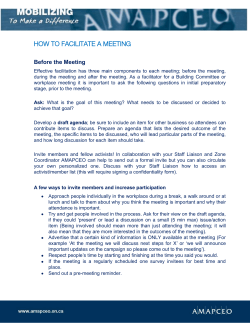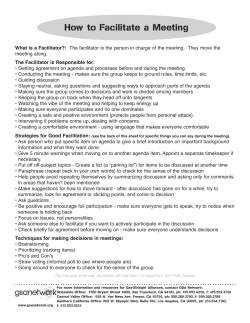
HOUSE MEETING ORGANIZING GUIDE (BETA)
HOUSE MEETING ORGANIZING GUIDE (BETA) Table of Contents What is a house meeting? .......................................................................................................... 2 House meetings should be about: .......................................................................................... 2 What should happen at a house meeting?.............................................................................. 2 Getting started ........................................................................................................................... 2 1. Create a Team ............................................................................................................. 2 2. Pick an issue/topic package. ........................................................................................ 2 3. Pick a date, time and place. ......................................................................................... 2 4. Set an Agenda (sample pg 5). ..................................................................................... 3 5. Begin inviting people .................................................................................................... 3 6. Make sure to have a camera or video camera. ............................................................ 3 7. Send an email with background information to attendees. ........................................... 3 8. Prepare. ....................................................................................................................... 3 9. Reminder calls ............................................................................................................. 3 Day of ........................................................................................................................................ 3 1. Set up the room for the meeting. .................................................................................. 3 a. Success hint: ............................................................................................................... 3 2. Name tags and sign in sheets. ..................................................................................... 3 3. Essential roles ............................................................................................................. 4 a. Note taker. ................................................................................................................... 4 b. Timekeeper. ................................................................................................................. 4 c. Facilitator. .................................................................................................................... 4 4. Write up the notes from the meeting within 24 hours and turn them in. ........................ 4 5. Follow up with participants! .......................................................................................... 4 House meeting check list ........................................................................................................... 4 Phone Invitation Outline ............................................................................................................. 5 Sample phone invitation ............................................................................................................. 5 Sample house meeting agenda.................................................................................................. 6 What is a house meeting? A New Abolitionist Association house meeting is a small gathering of ten to fifteen people who come together to discuss the Cradle to Prison Pipeline®, how it affects our community and figuring out how we can step-up together and take action. At the end of a house meeting you should have accomplished these things. 1. Focused on a Cradle to Prison Pipeline® issue. 2. Built relationships through the sharing of life stories, situations, and perspectives. 3. Identified common concerns, goals, and values by discussing the Cradle to Prison Pipeline® and imagining a better future. 4. Stimulated involvement within an existing group and coordinate with other groups. 5. Identified people in the group who want to give leadership and direction. 6. Next steps. House meetings should be about: 1. Finding common ground, not competing ideologies 2. Understanding not arguing 3. Coming up with a common vision, not to complain about what is not working What should happen at a house meeting? House meetings give us one of the most powerful things of all: relationships. House meetings allows to grow has leaders and has child advocates so that we may dismantle the Cradle to Prison Pipeline®. That‟s said, house meetings should be full of conversation—hearing and being heard so that we can grow together. House meetings can be organized around an event, such as a group viewing of a televised candidate‟s forum or a video that focuses on a Cradle to Prison Pipeline® issue. We‟ve provided house meeting packages that can give you short videos to start your house meeting with. Getting started 1. Create a Team dedicated to house meetings and lead by the outreach organizer. Every important task gets a team. House meetings are important. The team should be at least five people but no more than 10. This team will be responsible for dividing up the responsibilities that come with planning a house meeting. 2. Pick an issue/topic package. We have readymade issue and topic packages that you can draw from. Make sure you tie the issue to your specific community so that people can see the effects of the issue. If you‟re simply introducing people to the association make you still site Cradle to Prison Pipeline® statistics and how it‟s affecting your community. 3. Pick a date, time and place. The date and time should be good for you and the people that you want to invite. For college students it may be a common hour or late at night. 4. 5. 6. 7. 8. 9. For high school students it may be right after school or during a study all block. Last, reserve a space right away, if you‟re off campus make sure everyone within reason can access the home. If you‟re on campus make sure everyone can access the dorm or common area. Set an Agenda (sample pg 5). This will be based off out the issue packet you choose but no matter what packet you choose you need to: Begin inviting people. Now that you know what your meeting is about, begin spreading the word starting with the people you know. Think about friends and neighbors who are involved in similar things. Next think about people who may not have been involved in the past, but are concerned about the state of your neighborhood and its future. Aim to invite at least 50 people, to ensure you have 15-20 people in attendance. You may also want to reach out to your larger community. You can find other NAA chapters and invite members to attend by emailing the group's listserv. You can create your own event flyers and post them at your local coffee shop, grocery store, or library. Encourage all of your attendees to RSVP for your event so you know how many people to expect. Make sure to have a camera or video camera. Take pictures or create a video to help tell your stories. Then share them with us after the event. Send an email with background information to attendees. Once you get a commitment of people you want to attend, make sure you send them a one-pager about the background of CDF, the New Abolitionist Association and an agenda so they know what to expect. Prepare. Make sure to check in with your team before the meeting to make sure you have any necessary equipment, snacks, handouts, sign-up sheets, and that everyone knows their roles during the meeting. Make sure you have a facilitator and note-taker at least - having a photographer, food and drink captain and sign-up sheet coordinator are also helpful roles. Reminder calls are essential to the success of your meeting. We all live such hectic lives that, if you want to be assured that people will attend, you will need to call them to remind them at least once at a reasonable time before the meeting before the meeting. Day of 1. Set up the room for the meeting. Make sure you know everything is set up right especially if it‟s not in an actual home. The room should be relatively free from outside noise. It should be set up ahead of time, if possible with seats in a circle so that no one has their back to anyone else. The facilitator should have a seat placing them in a central spot near everyone. If there is food, it ideally should be off to the side. a. Success hint: Be sure to create your own environment for success. Meaning, don‟t let unknown standards of others limit the possibility of your success. For example, if you were told that a room was going to set up with audio and video go early to check and give yourself enough time to get it fixed. Otherwise it could throw off your whole meeting. 2. Name tags and sign in sheets. It is always appreciated when people have cues to remember names. Place name tags and sign in sheet either at the entrance to your meeting room, or near any refreshments you may choose to serve, so it is convenient and not a burden to complete the tasks. 3. Essential roles a. Note taker. The information we receive from these house meetings is very important, so it is imperative that we have records of the discussions. This can either be accomplished by the host, or one of the guests who you think will understand the process enough to do a thorough job and who would be willing to type up their notes afterwards. If you plan to ask a guest to be the note taker, you may want to ask him/her in advance. If not, select someone at the beginning of the meeting. Let people know who will be taking notes so they don„t wonder, and so that they know that their thoughts will be recorded as part of the process. b. Timekeeper. You may want to ask someone in advance to be the timekeeper. If not, select someone at the beginning of the meeting. It should be someone who„ll be comfortable warning people that the time for a section is nearly up or asking someone to wrap up. Of course, as facilitator and/or host, you will have the best sense of your meeting and may decide to make some sections longer and others shorter. c. Facilitator. Notes on facilitating are in the below section: House meeting check list 4. Write up the notes from the meeting within 24 hours and turn them in. The note taker should put together the notes they took at the meeting, ideally typing them onto the note taker form. Ideally, he or she should do so soon after the meeting while their memories are still fresh, and run their notes by the facilitator. Email the completed form to Joe Worthy at jworthy@childrensdefense.org , your lead organizer and/or members of the Child Action Team at your school or organization. 5. Follow up with participants! Make sure you don‟t leave everyone hanging. Get on the phone or schedule a one to one to keep them engaged and recruit them to start helping. It‟s best to do this soon after the house meeting for two reasons. First, you will be able to judge how serious someone is about joining you and group. Second, you don‟t want the feeling of community and purpose form the meeting to wear off—if you wait too long people will forget out they felt at the meeting. House meeting check list Agendas: Bring copies of the short agenda for participants, and your own facilitator agenda. Make sure the host/you have a note-taker. You or the host should check in with the note- taker afterwards to make sure they sent in their notes. Make sure there is a timekeeper. Make sure people fill out the sign-in sheet. Explain the next steps around getting involved (is there an upcoming event or meeting that people would like to come to) and ask if anyone else would be interested in getting more involved and/or hosting another house meeting. After the house meeting ends, spend a few minutes evaluating with the host: What reactions from participants particularly strike you? Can we learn anything from this meeting regarding priorities? Who volunteered to host another house meeting? Get involved? (Make sure you “star” their names on the sign-in sheet. Who will write thank you and follow up notes with participants regarding future dates to meet? Who might get more involved if they got a follow-up call? Phone Invitation Outline Greeting and introduction. Explain your involvement in the Children‟s Defense Fund and the New Abolitionists Association. Explain a bit about The New Abolitionist Association at your site what the goal is of this meeting. Explain that you are inviting them to participate in a house meeting, where, when and what time and the significance of the meeting happening before or after a certain date. It is important to focus on a house meeting campaign during a certain time period so we can track momentum and success. Explain the purpose of the house meeting and that there will be more than over the time period. Identify the goals of the meeting: to talk about a personal story of the Cradle to Prison Pipeline® and/or issues important to you as it relates to your experience with the cradle to prison pipeline®. Ask if they or anyone else from their organization/community can attend this or another house meeting. Offer to e-mail additional info. Confirm attendance, or alternate action. Sample phone invitation Hi! This is ______ calling from _________ (name School or organization) and our New Abolitionist Association‟s work at the (School/Organization/Congregation). I‟m a host of an upcoming house meeting where we are bringing together community members and individuals from our (congregation/organization/School) to find systemic and innovative ways to address and create solutions to the things that keep us up at night, such as__________ (reference the Cradle to Prison Pipeline® your community most cares about.) We are organizing more than ___ house meetings within our community that will provide NAA members with the opportunity to come together and share with each other stories about how our common experiences of restriction or opportunity impact our lives. We want to build a more relational community and your story matters to us. I‟d like to invite you to the house meeting that I am hosting in my home (or at the home of ______) on_____. It will be around 15 - 25 people and last an hour and a half. At the meeting we will ask people to talk about a story or issues that are important to you so we may best prioritize the common themes/issues affecting our community, identify the structure impacting these issues, and build group momentum and leadership to make a difference. Will you be able to attend? As an individual or with someone else in your family or organization/congregation? Any questions? (If no, can you think of anyone you know who would be interested in this?) (If that day and time don‟t work, would you be willing to come to another meeting when it‟s more convenient? When is good for you?) If yes, ask for email and offer to send additional info and go over the agenda. Great! The meeting will be on _____ and will begin promptly at _____ and will end at_____. Thanks for your time. I‟ll see you on ______ Sample house meeting agenda I. II. III. IV. V. Welcome from Host- 5-10 Minutes a. Introduce yourself and ask your guest to sign in. Share your personal story including why you were inspired to hose this meeting and why you believe in the power of young people to dismantle the Cradle to Prison Pipeline® b. Allow guest to give a short introduction of themselves Watch the video clip form your issue packet 5-10 minutes a. Give them some context for what they‟re about to see and then when the video is over connect it to things that are happening in your state or locality. Share your Story- 20 minutes a. Invite your guest to share their personal stories, particularly how they pertain to the Cradle to Prison Pipeline® Discussion about themes of stories that have been heard- 20-30 minutes a. The lead should make sure each person has an opportunity to share their story b. How does your story connect with what you‟ve hear? How is it different? c. Collectively discuss the themes surfaced from the stories. What do stories have in common? What is different about our experiences? Next steps and Closing- 15 minutes a. Get feedback from around the room i. How did you like the house meeting? 1. What did you like? 2. How can we improve? ii. Did you have any takeaways? b. Make sure you have names and phone numbers of everyone involved c. Be sure to follow up and see if participants would like to hold their own house meeting with their peers. d. Make sure you get all of the data into a spread sheet of members as soon as possible e. Debrief the house meeting immediately after its over
© Copyright 2025





















